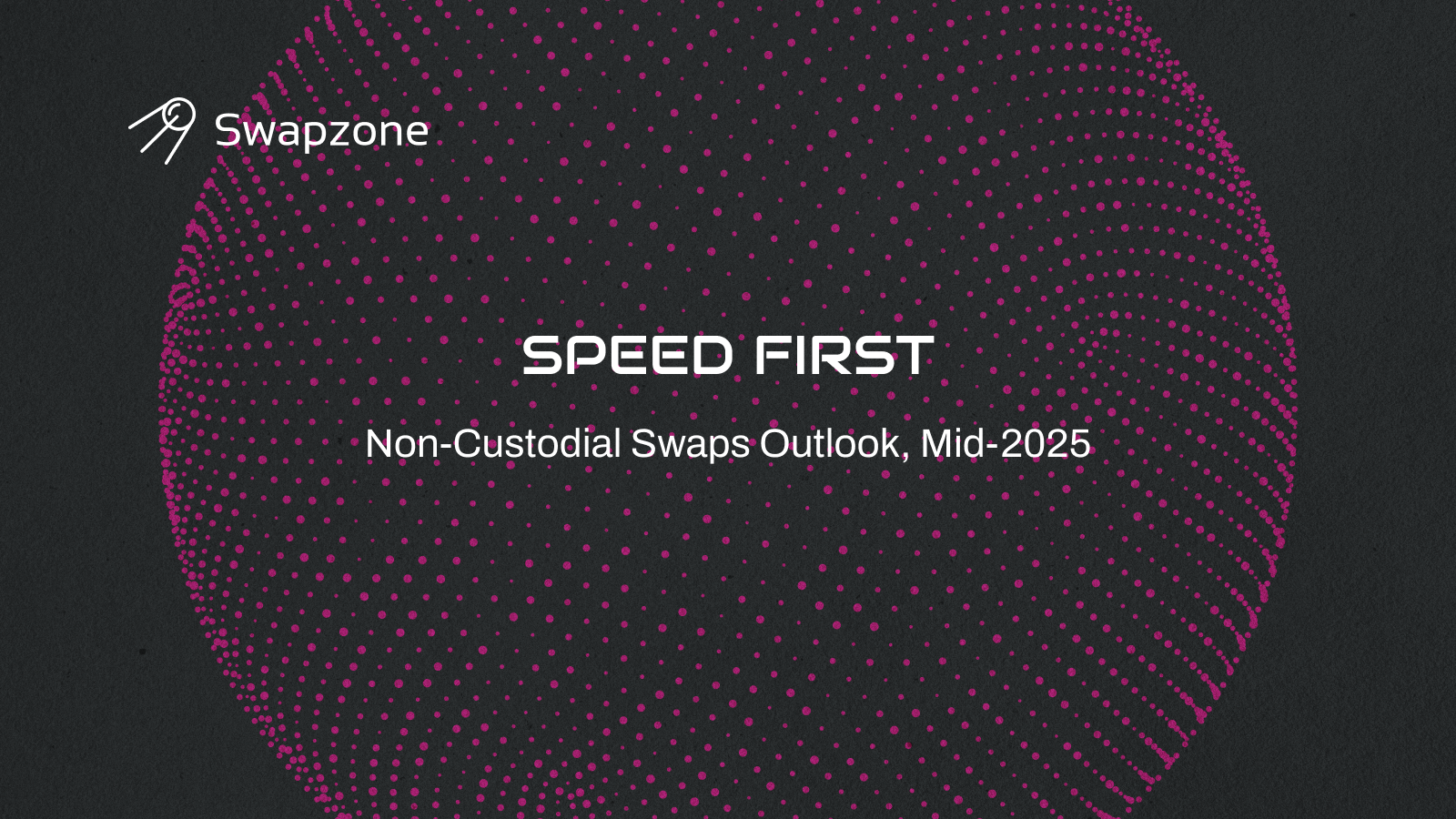In crypto, exchange time has become its own kind of currency. When prices change in seconds, how fast you can swap assets can make or break a trade. In the past, users often had to wait several minutes or longer for a swap to go through, which can be stressful when the market’s on the move.
At Swapzone, transaction speed is not just a convenience—it’s a critical factor in choosing a crypto exchange for both experienced and new users, driving mass adoption.
Why Speed Matters?
For example, a 2024 survey of South Korean crypto investors found that 26.8% ranked deposit and withdrawal speed as the most important factor when selecting an exchange, outranking liquidity and reputation. Globally, Binance’s 2024 User Survey of over 27,000 participants revealed that 17.2% cited transaction “speed and ease” as a key reason for entering crypto. And a recent Bitget Wallet report confirms this trend on a global scale: 46% of 4,599 respondents said they prefer crypto payments over fiat specifically because of faster transaction processing.
At the same time, speed limitations remain a barrier to mainstream use, industry studies highlight that slow network confirmations and congestion make crypto less practical for everyday retail transactions
With this in mind, we’re launching a series of reports to systematically track and benchmark swap processing speeds across top instant exchanges and emerging challengers. Our goal? To deliver clear, data-driven insights into how fast exchanges truly are, and where the market is heading.
Methodology: How We Measured Speed
To get a real sense of how fast crypto swaps are today, we ran a hands-on test across eight different exchange platforms. Also, to keep things balanced, we included both popular, high-traffic exchanges and smaller ones with lower activity. On each platform, we tracked the processing times of multiple swap transactions and calculated the median swap time (in minutes) as our main metric. Why median? Because it gives a better picture of what users actually experience without being thrown off by unusually fast or slow transactions.
We made sure to include a mix of well-known, high-traffic platforms like Changelly and ChangeNOW, along with some smaller players. All the testing happened during a set period in mid-2025, and we made sure conditions were stable – no crazy network slowdowns or unusual spikes, so that every platform was on equal ground.
For each swap, we measured how long it took from the moment the exchange detected the user’s confirmed deposit to the moment the swapped coins hit the user’s wallet. This includes both the blockchain confirmation time and the exchange’s internal processing time. We intentionally included the confirmation stage, since for users, the whole wait matters, not just the part the exchange controls.
In summary, our analysis followed these steps:
- Platform Selection.
Identify 8 non-custodial crypto swap services, ranging from large established exchanges to smaller entrants, for a broad comparison. - Data Gathering.
For each project, perform a set of test swaps under comparable conditions and record processing durations (from deposit confirmation to output delivery). - Metric Calculation.
Compute the median swap time for each platform overall. We first compared these overall median times across all 8 platforms to see the rankings of fastest exchanges in general. - Pair-Specific Timing.
For the top performers, we further broke down the timing by specific swap pairs (common popular pairs) to see if certain exchanges are faster for particular token swaps. - Qualitative Insights.
We conducted a brief anonymous survey of technical staff at the top exchanges to gather insight into their optimization efforts and goals regarding transaction speed. This provides context beyond the numbers, understanding why some platforms are faster and how others plan to improve.
We ensured that each tested swap involved a similar value and network fee conditions so that no exchange was given an unfair advantage or disadvantage due to external factors.
By combining real swap performance data with external benchmarks and industry commentary, our aim wasn’t just to point out which platform is fastest, but to understand how and why certain exchanges lead the pack and where others are still catching up.
1. Top Tier.
ChangeNOW and Changelly delivered consistently strong performance, with a median time of around 4 minutes. Given the scale they operate at, this is an impressive result. Both platforms handle high volumes and large asset libraries, yet manage to keep swap times low. ChangeNOW was also slightly more consistent across various swap scenarios (more on that below).
2. Mid Tier.
SimpleSwap and StealthEX posted median times around 6 minutes. That’s still reasonably fast, but about 1.5x slower than the leaders
3. Lower Tier.
This tier includes N.Exchange, Swapper, LetsExchange, and Coincraddle. Their median swap times ranged from 8 to 17 minutes, making them the slowest performers in our benchmark. While they remain functional, the longer processing times may negatively impact user experience, particularly during market volatility or time-sensitive trades.
To dig deeper, we took things a step further. After identifying the top-performing platforms overall, we ran additional tests, but this time focused only on the leaders.
We picked three swap pairs at random, chosen to represent a mix of networks and real-world use cases:
- USDT (TRC20) → ETH
- LTC → USDT (TRC20)
- USDT (BSC) → SOL
These pairs combined fast and moderately paced blockchains, giving us a well-rounded view of how each platform handles different transaction types.
This is where clearer front-runners started to emerge. In these specific tests, ChangeNOW showed a median swap time of around 1.8 minutes, while Changelly clocked in at about 2 minutes.
Inside the Race for Faster Swaps
To get a behind-the-scenes perspective on this drive for speed, we conducted an anonymous mini-survey of technical team members at the exchanges that led our speed tests. The responses were nearly unanimous in emphasizing that reducing processing times is one of the top priorities for their companies. Every expert we spoke with highlighted ongoing efforts to streamline their systems, integrate faster blockchain tech, and optimize protocols to shave off precious seconds from each swap.
One particularly illuminating insight came from a representative at ChangeNOW, who revealed:
“According to our internal benchmarks, our average processing speed is around 2 minutes. We’re constantly working to ensure the highest transaction time in the industry.”
Teams from several other exchanges expressed similar views. Their shared perspective is clear: as cryptocurrencies become faster and more scalable, the exchange infrastructure itself shouldn’t be the limiting factor. If blockchains can settle transactions in seconds, the rest of the swap flow should also be quick — from detecting the incoming payment to executing the trade and sending out the funds
Some experts highlighted ongoing improvements in transaction batching and parallel processing to handle multiple parts of the swap simultaneously. Others pointed to upcoming support for newer, high-speed blockchains and Layer-2 networks, which could significantly reduce delays.
Across the board, there was agreement that user expectations are rising fast. As one respondent put it, “People want to swap crypto as fast as sending an email – that’s the goal.” While some wait time is inevitable due to blockchain confirmation requirements (unless using fully off-chain systems), the priority is to make the entire experience feel as smooth and instantaneous as possible. Exchanges are now actively competing on speed — great news for users, as it means continuous progress. Most experts expect steady gains in the short term and major breakthroughs as new infrastructure and protocols mature.
Final Words
As we move forward, we anticipate the competition will further intensify. For users, this is a win-win: faster swaps, more choices, and the ability to capitalize on the crypto market’s fastest moving opportunities without worrying about waiting around. The trend is clear: exchange processing times are trending downward. While one report alone can’t predict the exact slope of that trend, all signs and insider insights point to an industry racing toward greater speed and efficiency. In the journey toward mainstream crypto adoption, transaction speed is a crucial piece of the puzzle. The sooner a crypto swap becomes as quick and effortless as a swipe of a credit card or a tap of a phone, the more likely everyday users are to embrace cryptocurrencies for their daily needs.


